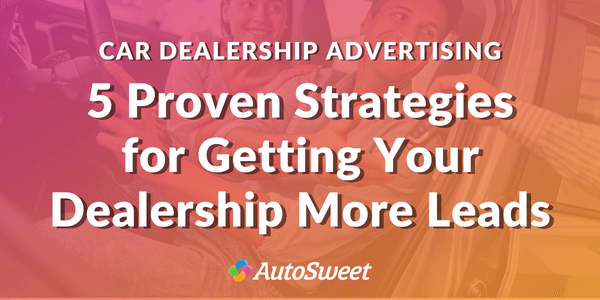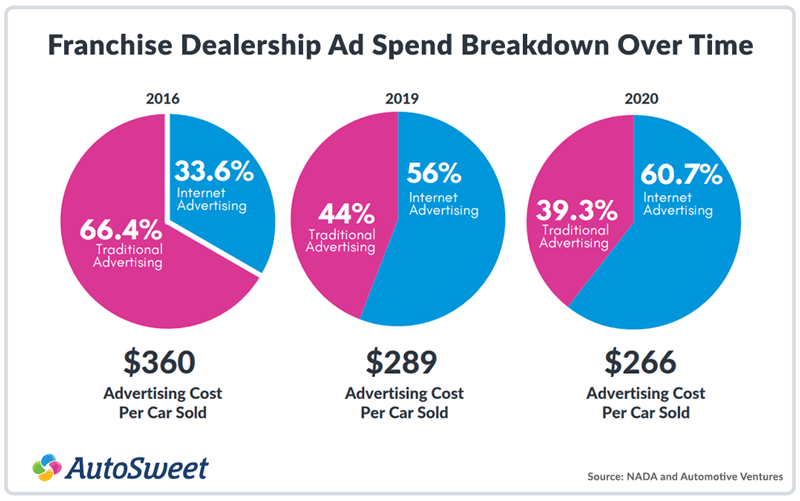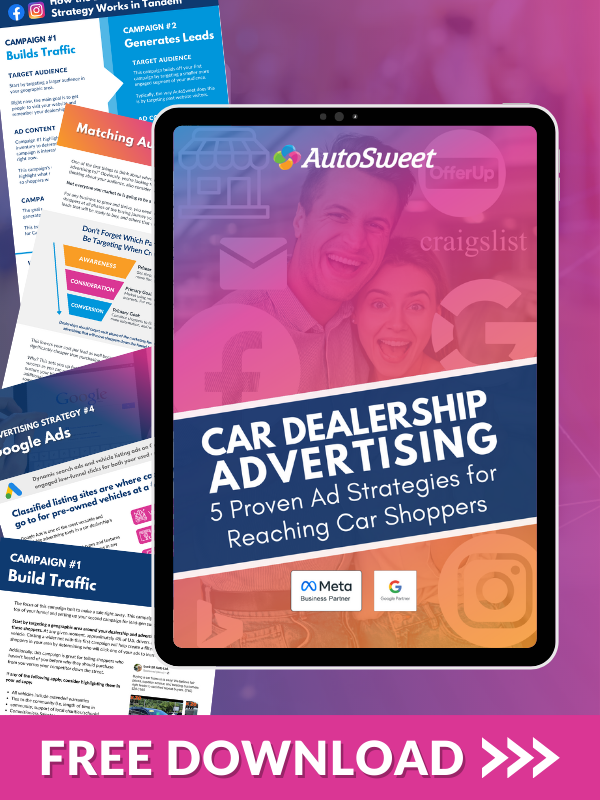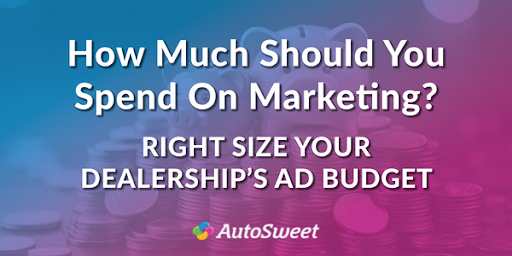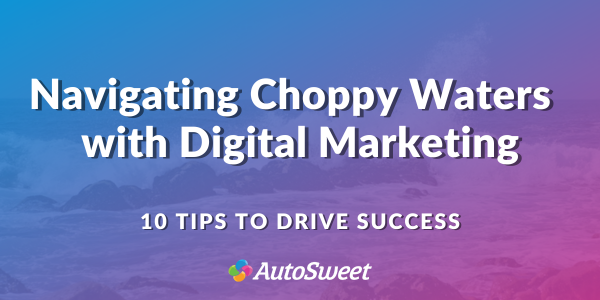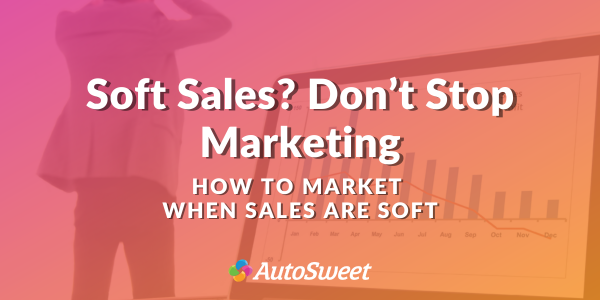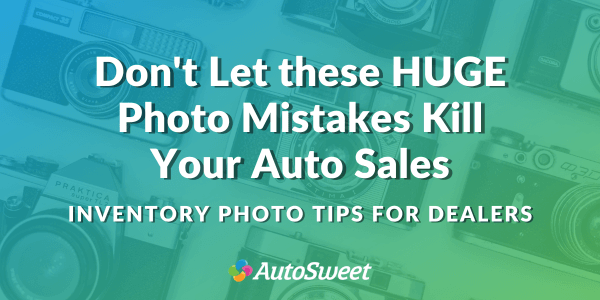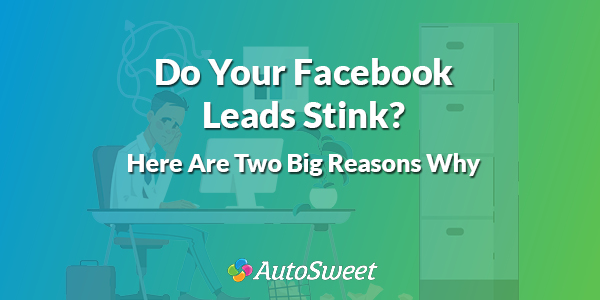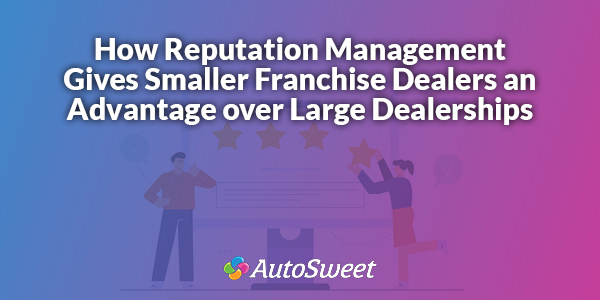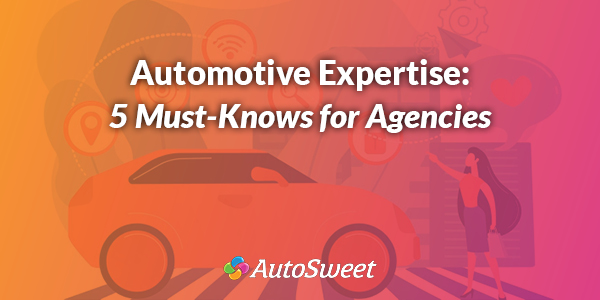Today, dealerships have more options than ever for advertising to car shoppers.
Old-school strategies like TV and radio ads, direct mail, and billboard advertisements are still very popular with dealers. But, will they get you the most bang for your buck?
Probably not…
In this blog post, we’ll explore five proven strategies dealerships can utilize to get the most out of their car advertising budget.
Important note: This isn’t your typical blog post with cookie-cutter marketing information. This post is packed with detailed advice about how to grow your dealership with advertising for less. With that in mind, it’s also a much longer than a typical blog post.
So, please feel free to bookmark this post so you can deep-dive into the content more later, or, click the banner above to download the free ebook that covers the same information with bonus content and graphics!
How Much Do Dealers Spend on Advertising to Sell One Car?
An analysis of 2016 DealerSocket data, revealed it costs roughly $150 in digital marketing spend to sell one car, compared to $1,581 using traditional media.
This stat also supports NADA reports showing franchise dealers shifting more and more of their ad budget toward Internet advertising. As this has happened, the advertising cost per car sold has also gone down by more than 30%!
Here’s a breakdown of the numbers for dealer ad spend by month per franchise dealer according to NADA:
2016
- Ad budgets are divided by 33.6% toward Internet Advertising and 66.4% towards traditional media (newspaper, direct mail, radio, and tv)
- $48,983 advertising budget per month and 136 average units sold
- $360 advertising cost per car sold
2019
- Ad budgets are divided by 56% toward Internet Advertising and 44% towards traditional media (newspaper, direct mail, radio, and tv)
- $46,191 advertising budget per month and 160 average units sold
- $289 advertising cost per car sold
2020
- Ad budgets are divided by 60.7% toward Internet Advertising and 39.3% towards traditional media
- $37,508 advertising budget per month and 141 average units sold
- $266 advertising cost per car sold
These numbers and trends really emphasize the power of Internet advertising compared to traditional advertising. That’s not to say traditional marketing tactics deserve zero budget.
These tactics still reach different audiences (i.e. older audiences who are technical laggards or people not actively in-market for a vehicle).
But, knowing how much more value you get for your money with digital, it’s definitely the advertising channel to focus on more. AutoSweet recommends spending roughly 80% of your overall advertising budget on digital channels and 20% on traditional channels.
This ensures you’re getting a good return on marketing investment while also reaching a wider audience.
And, if you’re running marketing on a strapped budget and are looking to grow fast then you may consider investing even more, or even all of your budget, into digital advertising.
With that in mind, this guide focuses on how to put together a cost-effective digital advertising strategy that will generate leads for your business.
Matching Audience to Strategy
One of the first things to think about when you begin advertising your car dealership is, “who am I advertising to?”
Obviously, you’re looking for car shoppers in your local area. But, when you’re thinking about your audience, also consider where they are in the buying process.
Not everyone you market to is going to be a ready-to-buy lead. Don’t write them off.
For any business to grow and thrive, you need to build a healthy pipeline of leads. By targeting shoppers at all phases of the buying journey you’ll diversify your advertising strategy with a mix of leads that will be ready to buy, and others that will take a bit more time.
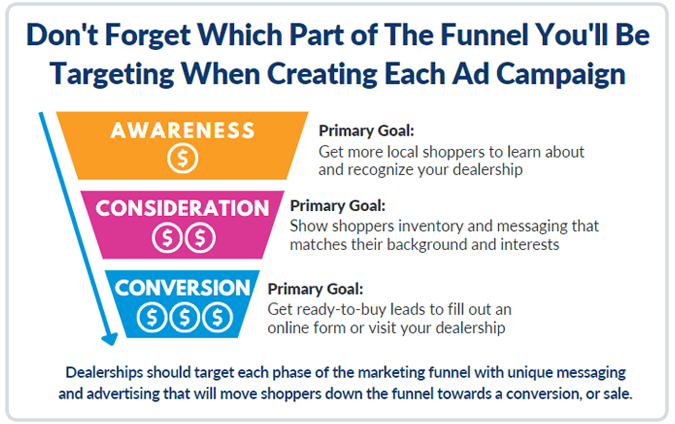
This lowers your cost per lead as well because converting a top-of-funnel shopper into a lead is significantly cheaper than purchasing more “ready-to-buy” leads from third-party websites like carmax.com or cars.com (more on this later).
Why?
This sets you up for long-term success as you can continue to nurture your high-funnel leads with additional advertising. Over time, some of these leads will then transform into “ready-to-buy.”
Advertising Strategy #1: Facebook & Instagram Ads
Between Facebook and Instagram, dealers can reach a huge portion of their local audience.
According to a 2021 Pew Research study, seven-in-ten adults in the United States are
Facebook users and, more than 70% of them are using Facebook daily!
Not only can Facebook Ads help you reach a large local audience, but by using a dual-campaign strategy, you can convert top-of-funnel leads to low-funnel leads.
This is our favorite advertising strategy at AutoSweet because it results in quality leads for less.
Here’s how it works…
Ad Campaign #1: Branding & Inventory-Focused Traffic Campaigns
The idea of this campaign isn’t necessarily to make a sale right away. Instead, think of it as your first chance to make a great first impression on a new customer in your local area.
We recommend targeting a geographic area around your dealership and advertising your inventory to these shoppers. Remember, at any given moment, 4% of U.S. drivers are in-market for a new vehicle. This number is based on the number of US Adults divided by the number of expected car sales in 2022.
At AutoSweet, we find that casting a wider net with one campaign to determine interest and drive traffic to your website (and specific vehicle pages) is the most cost-effective way to fill the top-of-your-funnel.
Additionally, this campaign is great for telling shoppers who haven’t heard of you before why they should purchase from you versus your competitor down the street.
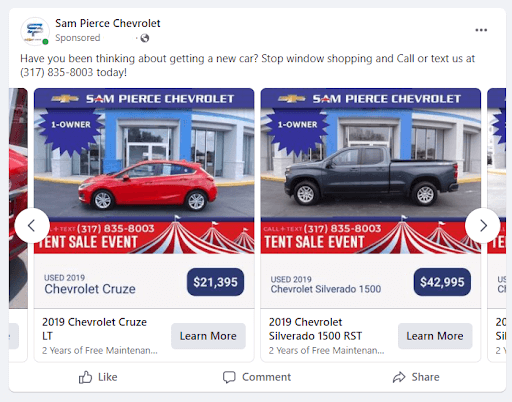
If any of the following apply, consider highlighting them in your ad copy:
- All vehicles include extended warranties
- Ties to the community (i.e. length of time in community, support of local charities/schools)
- Salespeople working on salary only (not commission-based)
- 24-hour test drives
- No-haggle pricing (always the lowest price)
- In-house financing options
- Free snacks & beverages while waiting
Basically, anything customers like that you do that your competitors aren’t doing (or aren’t advertising) is a selling point to new customers.
The goal of this ad campaign is to get potential shoppers to like and trust you more than your competitors while also driving traffic to your website.
Once a shopper in the awareness phase clicks your ad or visits your website, you can retarget them with more detailed ads highlighting what they’re interested in and nurturing them into ready-to-buy leads familiar with your brand.
This brings us to the second campaign in the dual-campaign strategy…
Ad Campaign #2: Remarketing Inventory Campaigns
The second campaign in a Facebook dual-campaign strategy requires you to have a solid foundation of monthly web traffic.
At AutoSweet, we recommend focusing on getting at least 3,000 unique visits to your website a month before starting a remarketing campaign. If you aren’t here yet, we recommend sticking with ad campaign #1 until you reach this point.
Once you have a solid amount of web traffic to your dealership’s website, inventory re-advertising on Facebook and Instagram is one of the most cost-effective ways to generate high-quality leads.
With these inventory ads, after someone visits your website you can show them a list of your current inventory, and if they viewed a specific vehicle, they’ll see an ad for that vehicle following them around.
Facebook and Instagram make it easier than ever for dealerships to make a connection with shoppers too. With lead forms, Facebook users can share information with you without even needing to leave the app. This reduces friction and greatly improves lead conversion rates.
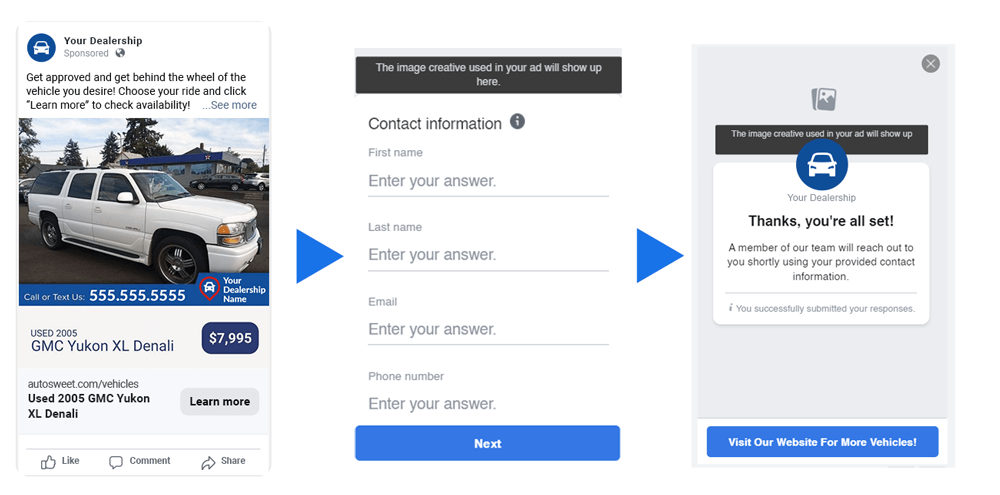
How The Dual-Campaign Strategies Work Together
Now, you might be wondering… if inventory ads are so great, why should I spend any money on branding ads?
Because these two advertising campaign types need to feed off each other to be most effective.
Now, depending on your dealership history, you may need to invest more into your traffic.
- If you’re a brand new dealership, then you’ll need to focus more on building brand awareness for new potential shoppers.
- Brand new dealerships often don’t have enough traffic to create a retargeting strategy (advertising providers like Facebook and Google set minimum thresholds)
- If you’re more established and already have a loyal customer base then you might focus more on advertising new and used inventory, buyback specials, and/or service specials to increase customer loyalty.
While your dual-campaign strategy works to transform top-of-funnel shoppers into purchases, our next strategy is an affordable way to get bottom-of-funnel leads for your dealership…
Advertising Strategy #2: Classified Advertising Websites like Craigslist, OfferUp, Facebook Marketplace
Popular websites like Facebook Marketplace, Craigslist, and OfferUp have essentially replaced the classified newspaper ads of days past.
These are the sites car shoppers turn to when they want to buy something pre-owned for a good price. And the great thing about advertising on these sites versus automotive-specific classified websites is you can generate mid to low-funnel leads at a much lower cost.
Facebook Marketplace once offered automated posting for free, but this service has been discontinued. But, dealers can still post vehicles manually for free. If you are a smaller dealership just starting out – this is a great way to get started with advertising.
Craigslist allows dealers to post for $5 a vehicle, and OfferUp gives dealerships a limited number of free listings per month. After this, there is a fee for their Promoted Placements.
Advertising Strategy #3: Google Ads for Low-Funnel Targeting and Remarketing
Google Ads is one of the most versatile and affordable advertising tools in a car dealership’s arsenal. There are a wide variety of ad types and features to choose from that can target shoppers in any phase of the marketing cycle.
And, one of the greatest things about Google Ads is that the platform is always adapting and adding new features for savvy dealership marketers.
One of the newest and most exciting advancements coming to Google Ads is Vehicle Listing Ads, more widely known on Google as shopping ads…
Vehicle Listing Ads (Shopping Ads)
Vehicle Listing Ads (VLAs) are perfect for attracting mid- and low-funnel shoppers at a much lower price point than third-party auto listing websites. For around $1 a click you can target shoppers actively searching for the specific vehicles you have in your inventory.
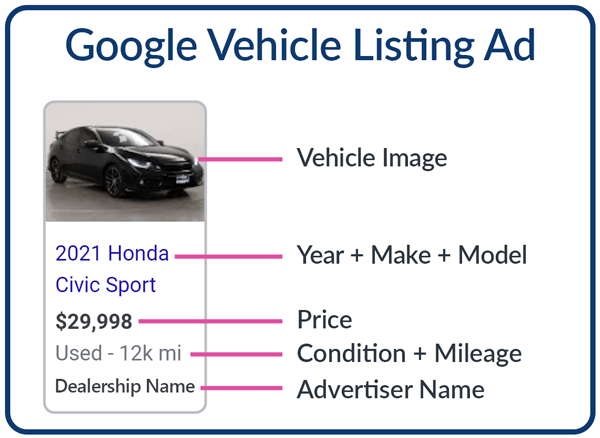
An Important Note on VLAs
Because this is such a new product, Google is only allowing certain partners to run these ads.
Today, AutoSweet is one of the marketing partners able to roll this ad type out to dealerships. Make sure to reach out to us for a Google Ads for car dealerships demo & strategy session if you’re interested in learning more.
Dynamic Search Ads
Similar to Vehicle Listing Ads, but without the visual element, dynamic search ads are great for attracting mid-funnel and low-funnel leads.
Dealerships can sync their website to Google Ads to produce dynamic search ads. Or, even better, a partner like AutoSweet can sync your DMS data and your website to Google Ads so your search ads are always relevant.
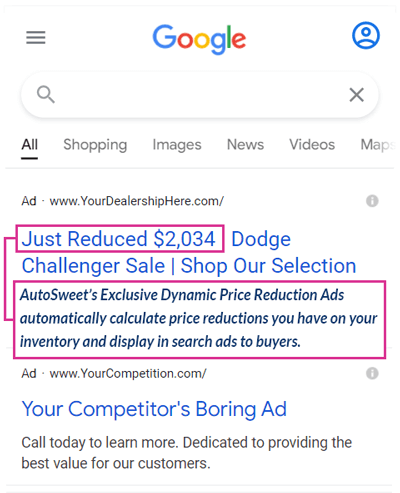
Then, when shoppers in your area search for a vehicle on Google that you have on your lot, your ad is listed with specific details about your dealership and the vehicle.
Quick shameless plug: AutoSweet is the only marketing partner offering automatic price reduction ads. These ads are created using your DMS data to highlight how much prices have been reduced from the original price.
Display Ads
Google’s Display Ads are great at doing two things for car dealerships:
- Casting a wide net to target in-market car shoppers by relying on Google’s machine learning data
- Retargeting shoppers who are already in your funnel either by targeting people who have visited your website or by uploading your CMS data to create a custom audience list.
Advertising Strategy #4: Automotive Specific Third-Party Listing Sites
Classified vehicle listing websites are very popular with dealerships. This is because they tend to produce leads that are “ready to buy”.
In the marketing world, these are often called “low-funnel” leads and are a very important part of your advertising strategy. But, it’s important not to put all of your eggs in this basket.
While there are a lot of “pros” to investing in third-party listing websites, there are “cons” as well.
Investing only in leads from third-party sites (especially expensive auto-specific sites like CarGurus or TrueCar) will be significantly more expensive and yield diminishing returns.
These companies tend to collect inventory from not just your dealership, but all of your local competitors as well. The goal is to drive local shoppers to their website where your inventory will be competing against both local and national competitors.
At the end of the day, these companies are building their brand off of your inventory, and then asking you to foot the bill! They require you to pay them to list inventory AND for the leads they generate.
Ultimately, throwing all of your eggs in the third-party basket is a short-sighted strategy that grows someone else’s brand instead of your own.
These lead sources will always be the most expensive and lowest-outputting because they’re extremely competitive, and not everyone who is shopping for a car is ready to fill out a lead form yet.
With that said, third-party leads are a great way to get fast, low-funnel leads. But we encourage you to only use this advertising strategy as a supplement to your overall digital strategy.
Your end goal should be to build your brand, increase traffic to your own website, and eventually limit your contribution to paid automotive third-party listing websites.
Advertising Strategy #5: Email Marketing
Email marketing is a great way to advertise to target shoppers directly. But, this strategy isn’t for everyone.
At AutoSweet, we generally only recommend email marketing to franchise dealerships or very large independents. This is because you need to have a large inventory and be able to afford a large and reliable list to get started.
If you are a franchise dealer though, email marketing can help you get an incredible bang for your buck!
We recommend two primary campaign strategies for email marketing.
- Conquest Email Marketing – This strategy is perfect for reaching new shoppers who haven’t worked with your dealership before. It’s an effective and affordable way to fill the top of your funnel.
- Loyalty Email Marketing – This strategy relies on your CMS data to retarget any of your previous shoppers or customers. It’s a particularly effective strategy for targeting customers who have purchased leases from your dealership that are nearing expiration.
Conquest Email Marketing
Before you can begin a conquest email marketing campaign, you need to figure out who you’ll be emailing. This is the step in the process where many dealerships falter. So, make sure to spend time and effort on your email list.
Putting together a solid email list and continuing to maintain it is the best way to ensure the success of a conquest email campaign.
AutoSweet has developed a proven process for generating this list for our clients:
- We start by analyzing DMS data to find your dealership’s highest performing zip codes
- We generate an initial list targeting these zip codes using high-tier affiliate data obtained from big-box retailers
- We remove any emails that are in your DMS and refresh them with new emails
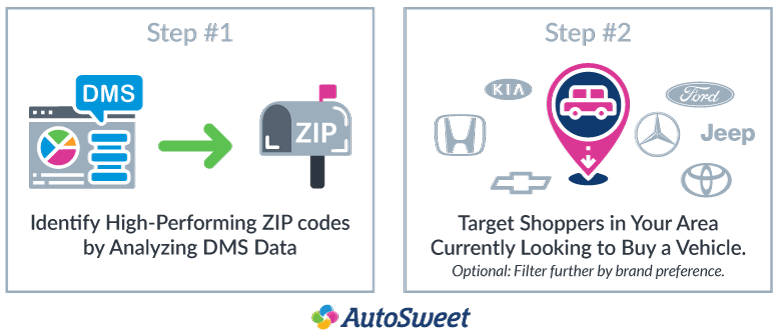
The result of this process is a true conquest list.
Whether you work with automotive email marketing specialists, like AutoSweet, or create your list another way, it’s imperative that you continue to improve your list over time.
The list is refreshed monthly and replaced with new contacts so it’s always getting better with time.
We remove chronic “un-openers”, known honeypot email addresses, and any email that purchases for your dealership
Loyalty Email Marketing
Loyalty email campaigns are cheaper than conquest email campaigns because they rely on your own data. But most importantly, they keep your brand in the mind of your customers. If you are touching them regularly, your competitors will be advertising to them and conquesting them.y
But, this can be a double-edged sword. Your loyalty emails will only be as good as your data. So, before you start a loyalty campaign, be sure your team is religiously collecting emails at the point of sale and on your website.
Accurate email data from past shoppers is the key to your success with this campaign type.
Once you have a solid starting list built from your own data, loyalty email campaigns can help generate sales by:
- Advertising service specials like oil changes and tire replacements
- Showing your current inventory to past customers. You never know when one of your past customers will need a second vehicle!
- Showing trade-in specials to help you build up your pre-owned inventory and continuing to sell new (or newer) inventory
Need Help With Your Advertising Strategy?
Not sure where your dealership’s advertising budget would best be spent? You’re not alone. There is never a shortage of advertisers looking to help your dealership get in front of more shoppers.
But, depending on your dealer size, location, and current inventory there are certain strategies that will work better for you.
Fill out the form below for a free strategy session with one of our digital marketing experts.
